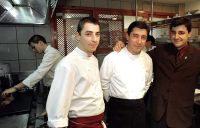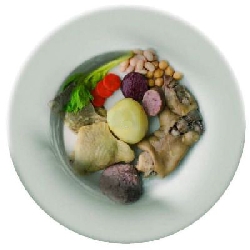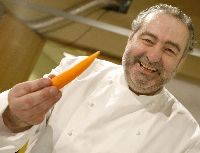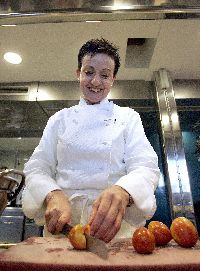

Cuisine 
Modern Catalan cuisine is admired all over the world because of generous doses of innovation it has incorporated while still retaining the identity conferred by so many years of tradition. Internationally-famous Catalan chefs include Ferran Adrià (1962), who reinvented cooking in his restaurant El Bulli, with three Michelin stars; Carme Ruscalleda (1952), who in her Sant Pau restaurant in Sant Pol de Mar creates a traditional yet modern cuisine which has earned her two Michelin stars, and Santi Santamaria (1957), who has been awarded three Michelin stars and four red forks for his Can Fabes establishment.
The basis of Catalan cuisine is the essential Mediterranean trio of wheat, oil and wine. The first known recipe book is the Llibre de Sent Soví (1324), which describes more than two hundred preparations. This cookery manuscript, one of the oldest in Europe, reveals that even at that time Catalonia enjoyed a refined and subtle cuisine.
In general terms, Catalan dishes can be divided into mountain and inland cookery – dominated by meat, milk products and produce from the woods, orchard and hen-run, coastal cookery – in which fish plays the leading role, often accompanied by rice, noodles or potatoes, and city cookery – which has reworked traditional dishes and adapted them to international tastes.
Amongst the essential basic products are vegetables such as onions, garlic and tomato (the basis of the sofregit, an almost universal foundation sauce), peppers and aubergines and legumes such as beans, peas, haricot beans and chickpeas. Almonds and hazelnuts are often an ingredient in meat and fish dishes, either on their own or in a picada (nuts and other ingredients pounded together, used to flavour and thicken).
The condiments used include spices such as cinnamon and saffron as well as aromatic herbs like bay, thyme, parsley, etc. Nor must we forget two characteristic sauces: allioli (“garlic and oil”, amalgamated into a smooth paste) and romesco (whose ingredients include pounded nuts, tomatoes and the pulp of nyores, small dried red peppers).
A wide variety of wild mushrooms inspires a large number of traditional dishes. Sausages and cured meats deserve a whole chapter. Fuet, sobrassada and many others) are accompanied by pa amb tomàquet, an iconic preparation that simply involves rubbing the pulp of a tomato on a slice of bread and anointing it with oil and salt.
To round off the meal, there is a wide variety of desserts and sweets that are associated with the various feast days of the liturgical year: torrons (almond bars) and neules (sweet tubular wafers) for Christmas, mones de pasqua (traditional cakes) for Easter, crema de Sant Josep (custard) for March, coques de Sant Joan (fruit-topped pastry) for midsummer and panallets (pine nut macaroons) for All Saints’ Day, for example.

T) The Roca brothers, Jordi (pastry chef),
Joan (head chef) and Josep (maitre d’)
of the Celler de Can Roca, Girona.
All this is complemented by wines which, although they were already prestigious in Roman times, have in recent decades undergone considerable improvement as the result of the planting of new varieties of grapes and the adoption of advanced wine-making techniques, with well-known districts including Priorat, Penedés and Alella. The wines are protected by nine DOs (Denominació d’Origen, or district with certified production). Cava, the sparkling wine that has been made for over a century by the champenoise method, particularly in the Penedès district, is now exported all over the world.
Amongst the most popular simple dishes, apart from tomato bread, are calçots (a special spring onion which is grilled), xató (cod and tuna salad), paella valenciana, escudilla i carn d’olla (Catalan soup with boiled meats and vegetables, served in two courses), trinxat (a chopped-vegetable dish); and in the dessert department, ensaïmada (Mallorcan pastry), carquinyolis (almond biscuits), crema catalana (custard with a caramelized topping), catànies (chocolate-coated almond sweets) and others.






